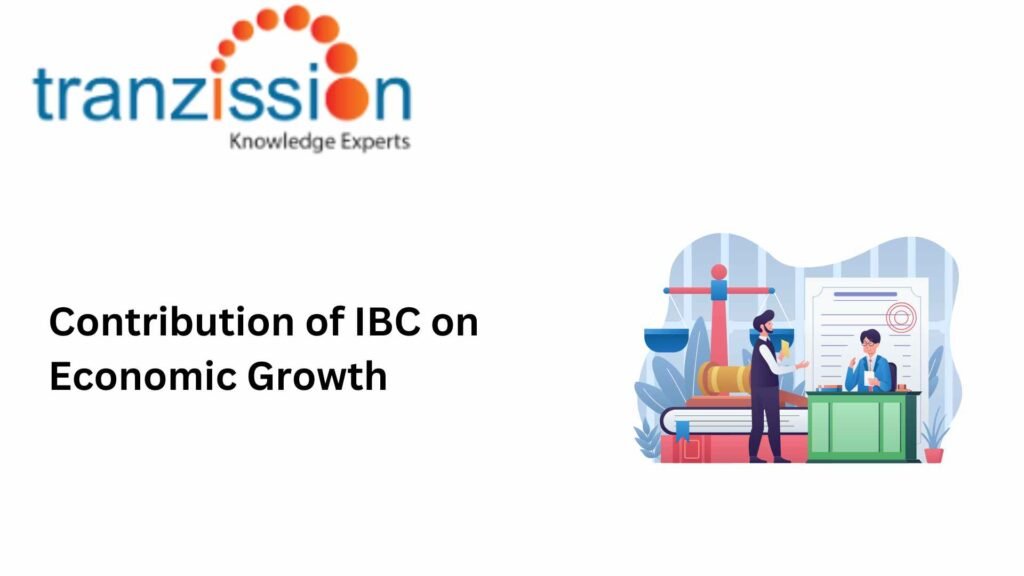The Insolvency and Bankruptcy Code, 2016 (the IBC) came into effect with several objectives, such as maximising the value of debtor’s assets, promoting entrepreneurship, ensuring timely resolution of cases, and balancing the interests of all stakeholders. By fulfilling its objectives, the IBC on Economic Growth contributes of India.
The Role of IBC on Economic Growth
The IBC aims to resolve the financial situation of struggling businesses and has an indirect role in the economy:
Read more : Addressing the Issue of Delay in Insolvency and Bankruptcy Law
Boosting Economic Efficiency:
Providing a streamlined insolvency resolution enhances resource allocation and reduction in bad debts and allows financial institutions to reallocate capital efficiently.
Attracting Investments:
The insolvency process under the IBC on Economic Growth ensures transparency and legal certainty. This fosters investor confidence in the resolution proceedings. Therefore, international investors view IBC as a benchmark for India’s business reforms.
Enhancing Ease of Doing Business:
IBC has significantly improved India’s rankings in global indices like the World Bank’s Ease of Doing Business report. This is because the IBC on Economic Growth mainly focuses on quick resolutions and minimises business disruptions.
Economic Contributions of the IBC
The IBC on Economic Growth has significantly contributed to the Indian economy by facilitating the timely resolution of distressed businesses, reducing non-performing assets (NPAs) in the banking system, protecting employment, and strengthening financial systems:
Read more : Doctrine of Commercial Wisdom of CoC
Recovery of Stressed Assets:
By providing a structured process for asset recovery has reduced the burden of NPAs on bank balance sheets, freeing up capital for fresh lending and improving bank stability.
Corporate Restructuring and Survival:
The insolvency process makes an effort to prevent the liquidation of viable businesses by promoting restructuring. The process of corporate restructuring helps to remove and repair all financial crises by enhancing the company’s performance.
Employment Preservation:
The insolvency professional has the responsibility to manage the affairs of the corporate debtor during the resolution process as a going concern. This business continuity, the IBC safeguards the employment when the company experiences insolvency.
Strengthening Financial Systems:
The IBC has improved financial discipline among borrowers and reduced credit risks for banks and other lending institutions.
Key Achievements of the IBC
NCLT as a Game-Changer:
The Adjudicating Authority is the National Company Law Tribunal (NCLT). The NCLT ensures the efficiency of insolvency resolutions and focuses on protecting creditor rights, all while maintaining a balanced approach.
Paradigm Shift in Credit Culture:
Borrowers are now more conscious of fulfilling obligations to avoid insolvency proceedings. Therefore, the IBC has encouraged more responsible borrowing and corporate governance.
International Recognition:
The international recognition of the IBC is primarily achieved through bilateral agreements with other countries under section 234. This allows the Central Government to enter agreements for resolving cross-border insolvency cases, meaning that full international recognition depends on the arrangements with other jurisdictions.
Challenges in Implementing the IBC
The key challenges in implementing the IBC include delays in the resolution process, court backlogs, and conflicts between stakeholders:
Delays in Resolution:
Despite the aim for quick resolution, insolvency matters are often delayed due to procedural inefficiencies and legal challenges. Therefore, many cases often exceed the prescribed 330 days under section 12 of the IBC.
Limited Capacity of NCLT:
The NCLT and the National Company Law Appellate Tribunal (NCLAT) are often overburdened which leads to a backlog of cases. Hence, there is a need for expansion in infrastructure.
Stakeholder Resistance:
Creditors and debtors often have conflicting objectives as there is a lack of understanding of the IBC among stakeholders. In addition to this, inadequate information sharing between shareholders can hinder the decision-making process during insolvency resolution.
Practical Takeaways for Insolvency Professionals
Insolvency professionals minimise economic disruption as they facilitate the orderly resolution of failing businesses. The main focus of insolvency professionals under the IBC is to ensure the smooth resolution of distressed companies while protecting the value of their assets. Insolvency professionals should thoroughly review financial statements, legal documents, and operational details to gain a comprehensive understanding of the debtor’s situation. They aim to reduce any legal and procedural delays and ensure adherence to timelines.
Conclusion
The IBC has transformed India’s economic landscape by promoting financial discipline, enhancing business continuity, and fostering global investor confidence. By resolving insolvency cases more efficiently, the IBC has contributed to strengthening the Indian banking sector. It has improved the financial landscape by encouraging responsible credit practices and enabling smoother business restructuring in distressed situations. Thereby it boosts investor trust in the Indian market.
Frequently Asked Questions (FAQs)
1. How has the IBC contributed to India’s economic growth?
The IBC improves credit market health, encourages investments, and enables distressed businesses to be revived or liquidated efficiently, leading to better utilisation of capital and economic stability.
2. What are the key achievements of the IBC so far?
Since its enactment, the IBC has achieved higher recovery rates for creditors, resolved large amounts of stressed assets, streamlined the process through a unified framework, and reduced the resolution time in comparison to the previous mechanisms.
3. What challenges does the IBC face?
The IBC faces delays in the resolution of insolvency cases, a high rate of liquidation rather than resolution, an inadequate number of NCLT benches, a lack of cross-border framework, and asset valuation difficulties.
